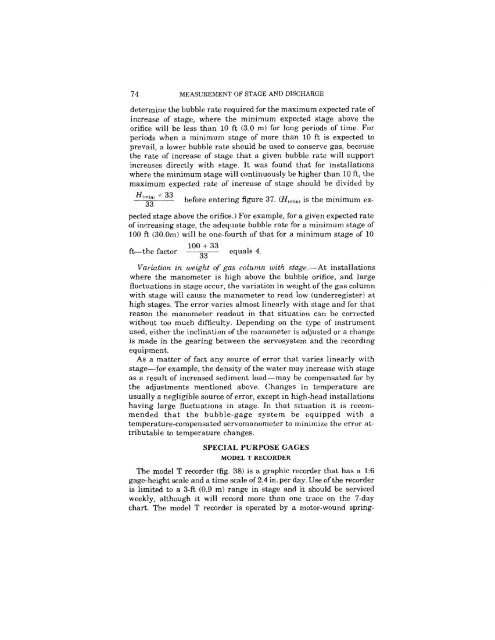PCWA-L 467.pdf - PCWA Middle Fork American River Project ...
PCWA-L 467.pdf - PCWA Middle Fork American River Project ...
PCWA-L 467.pdf - PCWA Middle Fork American River Project ...
Create successful ePaper yourself
Turn your PDF publications into a flip-book with our unique Google optimized e-Paper software.
74 MEASUREMENT OF STAGE AND DISCHARGE<br />
determine the bubble rate required for the maximum expected rate of<br />
increase of stage, where the minimum expected stage above the<br />
orifice will be less than 10 ft (3,0 m) for long periods of time, For<br />
periods when a minimum stage of more than 10 ft is expected to<br />
prevail, a lower bubble rate should be used to conserve gas, because<br />
the rate of increase of stage that a given bubble rate will support<br />
increases directly with stage, It was found that for installations<br />
where the minimum stage will continuously be higher than 10 ft, the<br />
maximum expected rate of increase of stage should be divided by<br />
H(minl + 33<br />
33<br />
before entering figure 37. (H,mhl) is the minimum ex-<br />
pected stage above the orifice,) For example, for a given expected rate<br />
of increasing stage, the adequate bubble rate for a minimum stage of<br />
100 ft (30,Om) will be one-fourth of that for a minimum stage of 10<br />
100 + 33<br />
ft--the factor 33 equals 4,<br />
Variation in weight 0{ gas column with stage.-·-At installations<br />
where the manometer is high above the bubhle orifice, and large<br />
fluctuations in stage occur, the variation in weight ofthe gas column<br />
with stage will cause the manometer to read low (underregister) at<br />
high stages, The error varies almost linearly with stage and for that<br />
reaSOn the manometer readout in that situation can be corrected<br />
without too much difficulty, Depending on the type of instrument<br />
used, either the inclination of the manometer is adjusted or a change<br />
is made in the gearing between the servosystem and the recording<br />
equipment,<br />
As a matter of fact any source of error that varies linearly with<br />
stage-for example, the density of the water may increase with stage<br />
as a result of increased sediment load-may be compensated for by<br />
the adjustments mentioned above. Changes in temperature are<br />
usually a negligible source oferror, except in high-head installations<br />
having large fluctuations in stage. In that situation it is recommended<br />
that the hubble-gage system he equipped with a<br />
temperature-compensated servomanometer to minimize the error attributable<br />
to temperature changes.<br />
SPECIAL PURPOSE GAGES<br />
MODEL T RECORDER<br />
The model T recorder (fig, 38) is a graphic recorder that has a 1:6<br />
gage-height scale and a time scale of2.4 in,per day, Use ofthe recorder<br />
is limited to a 3-ft (0,9 m) range in stage and it should be serviced<br />
weekly, although it will record more than one trace on the 7-day<br />
chart. The model T recorder is operated by a motor-wound spring-
















